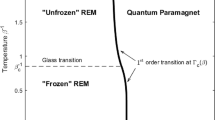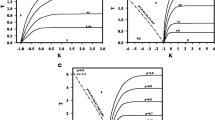Abstract:
A spin-1 model, appropriated to study the competition between bilinear (J ij S i S j ) and biquadratic (K ij S i 2 S j 2) random interactions, both of them with zero mean, is investigated. The interactions are infinite-ranged and the replica method is employed. Within the replica-symmetric assumption, the system presents two phases, namely, paramagnetic and spin-glass, separated by a continuous transition line. The stability analysis of the replica-symmetric solution yields, besides the usual instability associated with the spin-glass ordering, a new phase due to the random biquadratic couplings between the spins.
Similar content being viewed by others
Author information
Authors and Affiliations
Additional information
Received 18 May 1999 and Received in final form 20 October 1999
Rights and permissions
About this article
Cite this article
de Araújo, J., da Costa, F. & Nobre, F. Effects of random biquadratic couplings in a spin-1 spin-glass model. Eur. Phys. J. B 14, 661–667 (2000). https://doi.org/10.1007/s100510051076
Published:
Issue Date:
DOI: https://doi.org/10.1007/s100510051076




